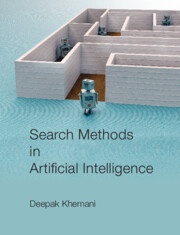Book contents
- Frontmatter
- Contents
- Preface
- Acknowledgements
- 1 Introduction
- 2 Search Spaces
- 3 Blind Search
- 4 Heuristic Search
- 5 Stochastic Local Search
- 6 Algorithm A* and Variations
- 7 Problem Decomposition
- 8 Chess and Other Games
- 9 Automated Planning
- 10 Deduction as Search
- 11 Search in Machine Learning
- 12 Constraint Satisfaction
- Appendix: Algorithm and Pseudocode Conventions
- References
- Index
1 - Introduction
Published online by Cambridge University Press: 30 April 2024
- Frontmatter
- Contents
- Preface
- Acknowledgements
- 1 Introduction
- 2 Search Spaces
- 3 Blind Search
- 4 Heuristic Search
- 5 Stochastic Local Search
- 6 Algorithm A* and Variations
- 7 Problem Decomposition
- 8 Chess and Other Games
- 9 Automated Planning
- 10 Deduction as Search
- 11 Search in Machine Learning
- 12 Constraint Satisfaction
- Appendix: Algorithm and Pseudocode Conventions
- References
- Index
Summary
We will adopt the overall goal of artificial intelligence (AI) to be ‘to build machines with minds, in the full and literal sense’ as prescribed by the Canadian philosopher John Haugeland (1985).
Not to create machines with a clever imitation of human-like intelligence. Or machines that exhibit behaviours that would be considered intelligent if done by humans – but to build machines that reason.
This book focuses on search methods for problem solving. We expect the user to define the goals to be achieved and the domain description, including the moves available with the machine. The machine then finds a solution employing first principles methods based on search. A process of trial and error. The ability to explore different options is fundamental to thinking.
As we describe subsequently, such methods are just amongst the many in the armoury of an intelligent agent. Understanding and representing the world, learning from past experiences, and communicating with natural language are other equally important abilities, but beyond the scope of this book. We also do not assume that the agent has meta-level abilities of being self-aware and having goals of its own. While these have a philosophical value, our goal is to make machines do something useful, with as general a problem solving approach as possible.
This and other definitions of what AI is do not prescribe how to test if a machine is intelligent. In fact, there is no clear-cut universally accepted definition of intelligence. To put an end to the endless debates on machine intelligence that ensued, the brilliant scientist Alan Turing proposed a behavioural test.
Can Machines Think?
Ever since the possibility of building intelligent machines arose, there have been raging debates on whether machine intelligence is possible or not. All kinds of arguments have been put forth both for and against the possibility. It was perhaps to put an end to these arguments that Alan Turing (1950) proposed his famous imitation game, which we now call the Turing Test. The test is simply this: if a machine interacts with a human using text messages and can fool human judges a sufficiently large fraction of times that they are chatting with another human, then we can say that the machine has passed the test and is intelligent.
- Type
- Chapter
- Information
- Search Methods in Artificial Intelligence , pp. 1 - 28Publisher: Cambridge University PressPrint publication year: 2024

